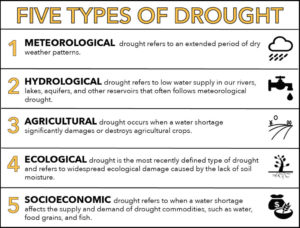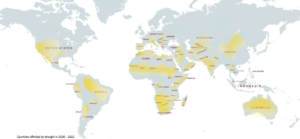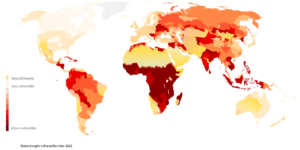ForumIAS announcing GS Foundation Program for UPSC CSE 2025-26 from 19 April. Click Here for more information.
Contents
| For 7PM Editorial Archives click HERE → |
Introduction
The UN Convention to Combat Desertification (UNCCD) has released the Drought in Numbers report. It is a collection of data on the effects of droughts the ecosystem. The Report notes down the areas that are most vulnerable to the droughts. Some regions of India are part of this list. The Report observes that droughts are not sudden like earthquakes or cyclones and do not leave behind similar trail of damage, destruction and debris. Hence they do not receive the news or policy priority like other disasters. However they are silent killers and their impact is much more damaging in the long term. It is time that mitigating the impacts of drought be a high priority for the Governments. The report has recommendations on how the impact of droughts can be mitigated through efficient planning for the future.
What are droughts?
According to the National Oceanic and Atmospheric Administration (NOAA), Drought is generally defined as “a deficiency of precipitation over an extended period of time (usually a season or more), resulting in a water shortage.”
The NOAA notes that Drought is the ‘absence of precipitation‘, rather than the presence of an event such as a hurricane, tornado, or fire. It’s often described as a ‘creeping phenomenon‘ because it slowly impacts many sectors of the economy and operates on many different timescales. It is also difficult to predict and monitor—particularly when marking the beginning and end of a period of drought.
Scientists generally define 5 kinds of droughts:
Source: NOAA
These 5 kinds of droughts generally proceed sequentially e.g., a prolonged meteorological drought can lead to hydrological drought. A hydrological drought can lead to agricultural drought eventually transforming to socioeconomic drought in the absence of any policy action.
What are the findings of the Drought in Numbers Report?
Anthropogenic Origins: There is a strong evidence that human induced climate change has increased the risk of droughts. The number and duration of droughts around the world has increased by an alarming 29% since 2000.
Widespread Impact: An estimated 55 million people globally are directly affected by droughts every year. Africa was the worst hit, with 134 drought events between 2000-2019, of which 70 occurred in East Africa. The report notes that by 2050, between 4.8 to 5.7 billion people will live in areas that are water-scarce for at least one month each year, up from 3.6 billion today.
Between 2020 and 2022, 23 countries have faced drought emergencies. These are Afghanistan, Angola, Brazil, Burkina Faso, Chile, Ethiopia, Iraq, Iran, Kazakhstan, Kenya, Lesotho, Mali, Mauritania, Madagascar, Malawi, Mozambique, Niger, Somalia, South Sudan, Syria, Pakistan, the U.S., and Zambia.
Source: UNCCD. The image depicts regions impacted by Droughts in the last 2 years. Large parts of Western and Central India have been hit by droughts.
The report says that climate change alone will cause 129 countries to experience an increase in drought exposure in the next few decades.
Source: UNCCD. The image depicts the regions vulnerable to droughts. The alarming aspect is the high vulnerability of regions in the African equatorial rainforests which normally receive heavy precipitation. In India, Kerala also has high vulnerability index which is a cause of concern.
Loss of Life: More than 10 million people lost their lives due to major drought events in the past century. From 1970 to 2019, drought was one of the deadliest hazard that led to the largest human losses, with a total of approximately 650,000 deaths. More than 90% of climate-related deaths occurred in developing countries. More than a billion people around the world were affected by drought in 2000-19, making it the second-worst disaster after flooding.
Loss of Biodiversity: The percentage of plants affected by droughts has more than doubled in the last 40 years. About 12 million hectares of land was lost each year due to drought and desertification. 14% of all wetlands critical for migratory species, as listed by Ramsar, are located in drought-prone regions. Australia’s ‘megadrought’ in 2019-2020 contributed to ‘megafires’ resulting in one of the most extensive losses of habitat for threatened species. About three billion animals were killed or displaced in the Australian wildfires. On a related note, 84% of all terrestrial ecosystems are threatened by changing and intensifying wildfires.
What are the harmful impacts of Droughts?
The Report observes that droughts have deep, widespread and underestimated impacts on societies, ecosystems, and economies, with only a portion of the actual losses accounted for.
Productivity: Drought can reduce the water availability and quality necessary for productive farms. It can also contribute to insect outbreaks, increases in wildfire, and altered rates of carbon, nutrient, and water cycling—impacting agricultural production. Drought is a major driver of crop yield volatility. The recent 2021-22 drought in Brazil, Argentina and Paraguay has resulted in loss of 20 million tonnes of soy. Canada’s Canola production fell 28% last year due to severe drought.
Economic Losses: The report observes that in the E.U. and U.K., annual losses from drought are currently estimated to be around EUR 9 billion. The losses are projected to rise to more than EUR 65 billion without meaningful climate action. In the U.S., crop failures and other economic losses due to drought have been estimated to be ~US$ 250 billion alone since 1980.
The report also stated that India’s Gross Domestic Product (GDP) reduced by 2 to 5% between 1998 and 2017 due to severe droughts in the country.
The report further observes that if predictions are correct and global warming causes temperatures to rise by 3°C by 2100, drought losses could be five times higher than today’s levels.
Migration: The World Bank estimates that up to 216 million people could be forced to migrate by 2050, largely due to droughts. Climate induced migration is going to create humanitarian crisis in future, with severe economic and political implications.
Impact on Ecosystems: ~33% of global carbon dioxide emissions are offset by the carbon uptake of terrestrial ecosystems. However, their capacity to sequester carbon is highly sensitive to drought events. The loss of biodiversity leads to loss of carbon sinks. Droughts will turn large proportion of terrestrial ecosystems from being carbon sinks to carbon sources. Photosynthesis in European ecosystems was reduced by 30% during the summer drought of 2003, which resulted in an estimated net carbon release of 0.5 gigatons.
Gender Impact: The impact of drought is not uniform across genders. Research shows that women and girls in emerging and developing countries suffer more in terms of education levels, nutrition, health, sanitation, and safety as a result of droughts. The burden of water collection also disproportionately falls on women (72%) and girls (9%). The report notes that women may spend up to 40% of their caloric intake fetching water.
What suggestions have been given in the report to mitigate impacts of droughts?
Shift in Approach: The report advocates a paradigm shift from ‘reactive’ and ‘crisis-based’ approaches to ‘proactive’ and ‘risk-based’ drought management approaches.
Land Management and Ecosystem Restoration: Proactive measures are required to reduce risks and increase resilience of ecosystems and communities. This can be achieved through sustainable land management and ecosystem restoration policies e.g., In Niger, farmers have substantially reduced drought risks by creating new agroforestry systems on 5 million hectares over 20 years, with average costs below US$ 20 per hectare.
The report lists several initiatives like natural forest regeneration, rotation forestry, regenerative agriculture etc. with some initial investments and relatively large returns.
Source: UNCCD
Sustainable Water Management: Water Management practices need to be adapted to ensure resilience against drought events e.g., The Integrated Resources Plan (IRP), adopted by the Southern California Metropolitan’s Board of Directors, ensures supply reliability under various drought conditions through 23 local projects and 200 conservation programs that will yield more than 197 million cubic meters of water per year.
Similarly, adopting drip irrigation and other sustainable water use practices can increase water use efficiency and the yield. This was evidenced in Vietnam where small-scale farmers helped improve water-use efficiency by up to 43% and yield by 8-15%.
Information Technology and Indigenous Knowledge with Intelligence (ITIKI) is a drought early warning system that integrates Indigenous knowledge and drought forecasting to help small-scale farmers make more informed decisions, for example, on when and how to plant which crops. Trials of forecast models based on this in Kenya and South Africa has shown accuracy of 70% to 98% for up to 4 years.
Education and Readiness: Through a program of ecological restoration-based education, farmers in the Colombian Amazon set up 71 novel nursery gardens, producing 400,000 seedlings of 21 native forest species.
Use Media to create awareness: A dedicated media campaign to create awareness about judicious use of water and minimizing wastage can bring behavioural change in masses. A case study of California in 2017 shows that an increase of about 100 drought stories over two months was associated with a reduction of 11-18% in typical household water-use.
Mitigation and Climate Action: Limiting global warming to 1.5 degrees Celsius, along with regenerative land and improved water management practices, is expected to substantially reduce the probability of extreme drought events.
What lies ahead?
The Drought in Numbers report has formed the basis of negotiations surrounding key decisions by the UNCCD’s 15th Conference of Parties (COP15). COP15 was held recently in Abidjan, Côte d’Ivoire. During the Conference, global consensus emerged on boosting drought resilience by identifying the expansion of drylands, improving national policies and early warning. The Conference concluded with a global pledge to invest in land restoration for future prosperity. While these developments are welcome, a persistent and concerted global effort is required to combat the threat posed by droughts.








